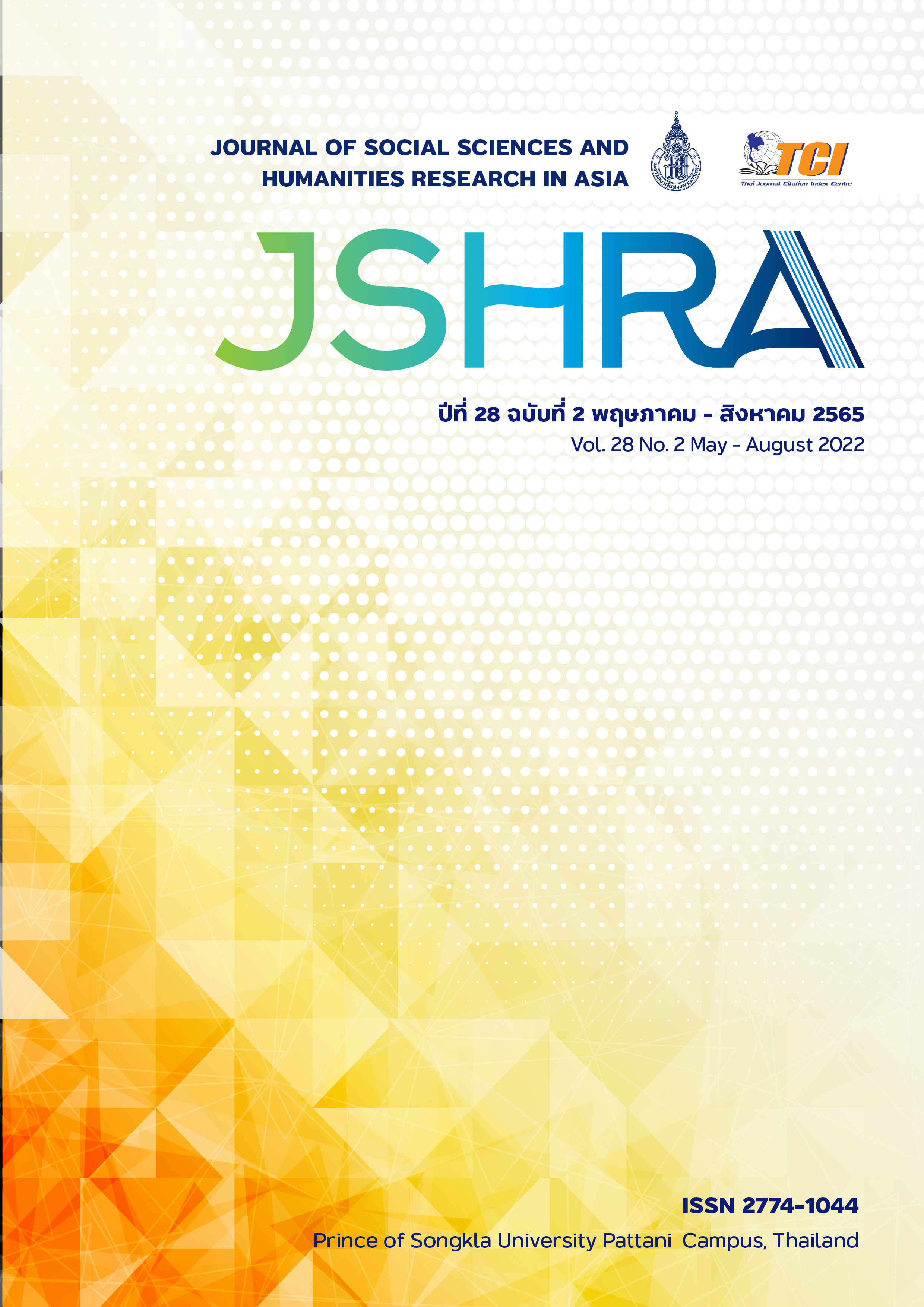Choice of Linguistic Landscape on Coffee Shop Signboards of Multilingual Communities
Keywords:
Language choice, coffeeshop signboards, language functions, multilingual communitiesAbstract
The dual-purpose of this research is to investigate the language on coffee shop signboards in multi-lingual communities, and to analyze the function of language used on coffee shop signboards in multilingual communities, Yala Municipality, based on the theoretical concept of
linguistic landscape. A mixed-method of quantitative and qualitative research was conducted to analyze visible and permanent coffee shop signboards in Yala Municipality. A total of 65 signboards were purposively selected to be the samples of this research with digital cameras and smartphone as research tools. The results showed that monolingual coffee shop signboards ranked at the top of with 56.92%, while bilingual signboard was followed at 40%, and multilingual signboards was the least of language choice at 3.07%. In terms of language displayed on the
signboards, the results were that English was regarded as the highest rate of 64.89%, and followed by Thai at 30.85%. Another result indicated that language on coffee shop signboards indicated the names of the shops (10.76%) and informed the shop details (3.07%). However, it was surprisingly found that 86.15% was the rate of language functions of providing both shop name and shop details. The results of the above study indicate the influence of the English language in that it has extensively spread in the beverage business to indicate shop name and its details with English for international context. On the other hand, it mirrors the ability of entrepreneurs in adopting English to elevate the coffee shop to more universal appeal through the language tool.
References
Gorter, D., Cenoz, J., & May, S. (2017). Language awareness and multilingualism. Switzerland: Springer.
Gorter, D. (2006). Linguistic landscape: A new approach to multilingualism. Clevedon: Multilingual matters.
Hayeesani, M., & Vongvivut, S. (2022). Multilingualism in southern border city: A case study of linguistics landscape of commercial shop signs in Yala City, Yala Province, Thailand. Parichart Journal, 35(2), 185-202.
Huebner, T. (2006). Bangkok’s linguistic landscapes: Environmental print, codemixing and language
change. International Journal of Multilingualism, 3(1), 31-51.
Karneva, S. (2020). Coffee places in Tilburg as linguistic landscapes. Retrieved March 01, 2022, from https://www.diggitmagazine.com/articles/coffee-places-tilburg-linguisticlandscapes-
Landry, R., & Bourhis, R.Y. (1997). Linguistic landscape and ethnolinguistic vitality. Journal of Language and Social Psychology, 16(1), 23-49.
Meemongkong, K. (2020). Linguistic landscape of a university in Thailand. Journal of Liberal Art, Rangsit University, 15(2), 165-185.
Methitham, P. (2017). English: Myth, power and domination. Phitsanulok: Naresuan University
Publishing House.
Office of the Municipal Clerk. (2020). General and basic information of Yala City Municipality. Retrieved February 26, 2022, from https://yalacity.go.th/files/general.pdf
Pikulthong, S. (2011). Languages on commercial signs along Phra Athit Road (Master’s Independent Study). Graduate School, Silpakorn University.
Piller, I. (2001). Identity constructions in multilingual advertising. Language in Society, 30(2), 153-186.
Prasithrathsint, A. (2001). Sociolinguistics (3rd ed.). Bangkok: Chulalongkorn University Press.
Rungswang, A. (2018). Linguistic landscape: Forms and functions of signs in Thai community center, Golden Mile Complex, in Singapore. TNI Journal of Business Administration and Languages, 6(1), 35-40.
Sarot, T., & Kraisame, S. (2019). Urban multilingualism: A case study of the relationship between
linguistic landscape and business in North Nana. Journal of Language and Culture, 38(1), 24-40.
Seangyen, C. (2015). Linguistic landscape on billboards in Mueang District, Udon Thani Province. Mekong Chi Mun Art and Culture Journal, 1(2), 13-36.
Setthitorn, S. (2019). Coffee shop business in Thailand. Thailand Food Market Report. Retrieved March 01, 2022, from http://fic.nfi.or.th/upload/market_overview/Rep_Cafe_15.01.62.pdf
Shohamy, E., & Waksman, S. (2009). Linguistic landscape as an ecological arena: Modalities,
meanings, negotiations, education. In Shohamy, E., & Gorter, D. (Eds.), Linguistic landscape: Expanding the scenery (pp. 313-331). New York: Routledge.
Spolsky, B., & Cooper, R.L. (1991). The Languages of Jerusalem. Oxford: Clarendon Press.
Suaykratok, P., & Manosuthikit, A. (2019). Inclusion of the minority language on public signs: Multilingualism in the deep south of Thailand. NIDA Journal of Language and
Communication, 24(35), 1-22.
Thongtong, T. (2016). A linguistic landscape study of signage on Nimmanhemin Road, a Lanna Chiangmai chill-out street. MANUSYA: Journal of Humanities, 22(Special Issue), 72-87.
Wangpusit, K. (2012). Business names in the area of Siam Square: A linguistic landscape study (Master’s Thesis. Master of Arts). Graduate School, Chulalongkorn University.
Zahra, S.T., Setia, E., & Zein, T. (2021). Linguistic landscape on coffee shop signboards in Medan. Budapest International Research and Critics Institute-Journal, 4(3), 5445-5457. https://doi.org/10.33258/birci.v4i3.2335











